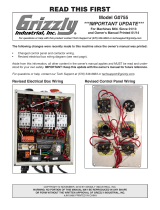Page is loading ...

For questions or help with this product contact Tech Support at (570) 546-9663 or techsupport@grizzly.com
MODEL G8750
6" X 18
1
⁄2" COMPOUND
SLIDE TABLE
INSTRUCTIONS
COPYRIGHT © MARCH, 2012 BY GRIZZLY INDUSTRIAL, INC., NOVEMBER, 2015 (ST)
WARNING: NO PORTION OF THIS MANUAL MAY BE REPRODUCED IN ANY SHAPE
OR FORM WITHOUT THE WRITTEN APPROVAL OF GRIZZLY INDUSTRIAL, INC.
#BL14920 PRINTED IN CHINA
Description Qty
A. Compound Slide Table ............................... 1
B. Handwheels ................................................ 2
C. Handwheel Lock Nuts ................................ 3
D. Handwheel Handles ................................... 3
E. Keys 4 x 4 x 10 ........................................... 3
Inventory
Introduction
The Model G8750 features 12" of longitudinal
travel and 7
1
⁄2" of cross travel, adjustable gibs,
dovetailed ways, Acme thread leadscrews, vernier
scales, and
9
⁄16" T-slots.
Description Qty
• Open-End Wrench 10mm ........................... 1
• Hex Wrench 4mm ....................................... 1
• Hex Wrench 5mm ....................................... 1
• Standard Screwdriver #2 ............................ 1
Tools Needed
Assembly
1. Secure the compound slide table by bolting
both sides of the base to your machine.
2. Place the 4 x 4 x 10 key onto the cross slide
(Y-axis) leadscrew, slide the handwheel onto
the leadscrew over the key, then hand tighten
the lock nut.
3. Hold the lock nut in position with a wrench
and tighten the set screw, as shown in Figure
1.
Wear safety glasses dur-
ing the assembly and
adjustment steps.
Figure 1. Securing the handwheel.
5. Repeat Steps 2–4 to install the longitudinal
(X-axis) handwheels. Make sure you install
these simultaneously. Otherwise, the lead-
screw could accidentally unwind from the
table and introduce backlash.
Lock Nut
Set Screw
4. Install the handwheel handle.

-2-
G8750 Compound Slide Table
Adjusting Gibs
The function of the gibs is to remove play in the
table and cross slide without causing the slides
to bind.
Each gib has multiple lock nuts and gib screws
that need to be adjusted. When adjusting, make
your adjustments equally and in small increments,
and test the feel of the table movement while
doing so until it feels right.
To adjust the gibs:
1. Loosen the lock nuts (see Figure 3).
2. Depending on current table movement, slight-
ly loosen or tighten each gib screw in equal
amounts, then move the table and test the
feel. When properly adjusted, the gibs should
offer slight resistance without binding.
3. Tighten the lock nuts without moving the gib
screws.
Figure 3.
Gib screws and lock nuts.
Table Gib Screw
& Lock Nut
Cross Slide Gib
Screw & Lock Nut
Lubrication
1. Keep the compound slide in good working
order by lubricating all moving parts frequent-
ly with general purpose oil.
2. Keep a thin layer of general purpose oil on
the table and other non-painted surfaces
when not in use to help prevent rust.
If you need help with your new compound slide
table, call our Tech Support at: (570) 546-9663.
Adjusting Backlash
When the handwheels are correctly installed they
contact the leadscrew support blocks (Figure 2),
and the table moves when the handwheels are
rotated.
Figure 2. Leadscrew support blocks.
Leadscrew
Support Blocks
To adjust backlash:
1. Rotate one of the X-axis handwheels until it
contacts the leadscrew support block.
2. On the opposite side of the table, push the
other handwheel against the leadscrew sup-
port block, loosen the set screw (see Figure
1) several turns, hand-tighten the lock, then
tighten the set screw.
The table will not move if either handwheel is not
touching a leadscrew support block.
The amount the handwheels rotate without mov-
ing the table is the backlash. Generally, 0.005"–
0.010" of backlash is acceptable.

G8750 Compound Slide Table
-3-
Parts breakdown provided for reference only. Not all parts shown are available for purchase.
G8750 Parts Breakdown and List
1
1
1
2
2
2
3
3
3
4
5
5
5
6
6
7
7A
24
7
7A
7
8
8
8
9
9
10
11
11
11
12
13
13
14
14
14
15
15
16
17
17
18
19
19
19
20
21
22
22
23
23
23
13
9
24
REF PART # DESCRIPTION REF PART # DESCRIPTION
1 P8750001 HANDWHEEL HANDLE 13 PSS17M SET SCREW M8-1.25 X 6
2 P8750002 HANDWHEEL 14 P8750014 STEEL SPRING
3 P8750003 GRADUATED DISC 15 P8750015 STOP COLLAR
4 P8750004 TABLE 16 P8750016 LONGITUDINAL LEADSCREW
5 PSS28M SET SCREW M6-1 X 30 17 P8750017 GIB
6 P8750006 LEADSCREW SUPPORT BLOCK 18 P8750018 CROSS LEADSCREW
7 P8750007 INDICATOR SCALE 19 P8750019 LOCK NUT
7A P8750007A SCALE W/RIVETS 1" SET 20 P8750020 BASE
8 P8750008 HANDWHEEL HANDLE SCREW M6-1 X 47 21 P8750021 CROSS SLIDE
9 PN01M HEX NUT M6-1 22 PSS02M SET SCREW M6-1 X 6
10 P8750010 CROSS LEADSCREW FLANGE 23 PK05M KEY 4 X 4 X 10
11 PCAP14M CAP SCREW M8-1.25 X 20 24 P8750024 ALUMINUM RIVET 2.3 X 3.65MM
12 P8750012 CROSS LEADSCREW NUT

/

